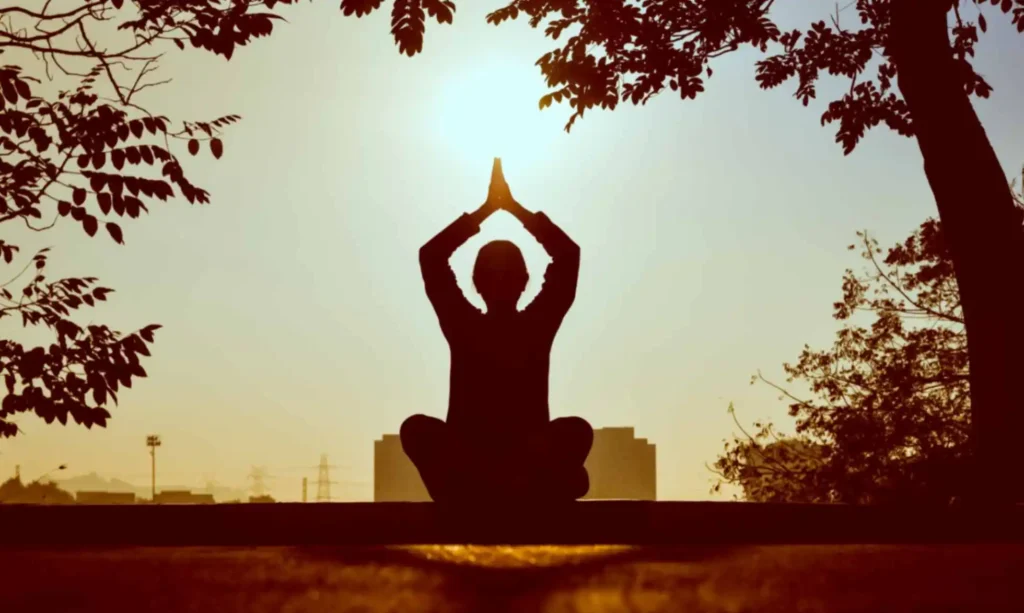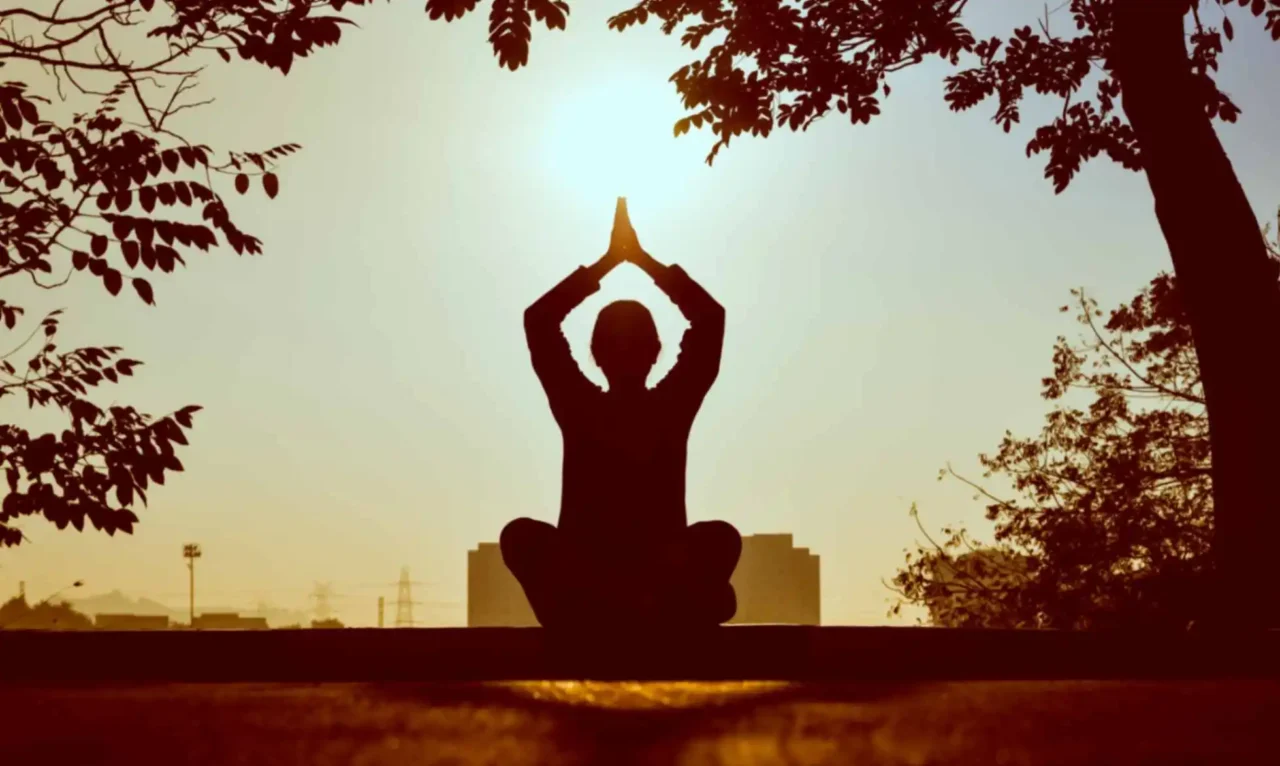Greetings from the peaceful world of meditation, a discipline that transports us from the cacophony of our daily existence to a calm haven within our own self. With its straightforward yet deep path to inner serenity and clarity, meditation acts as a kind guide in a world where distractions abound and pace appears unending. All it takes to practice this age-old technique is some peaceful time and an open mind. Come along on a journey where the stillness inside gradually replaces the commotion outside, and the whispering of your breath become the song of tranquility. Greetings from the world of meditation, where the heart finds its own rhythm and silence says volumes.

Table of Contents
What is Meditation?
Meditation is a practice that involves focusing the mind and eliminating distractions to achieve a state of calm and heightened awareness. It often includes finding a quiet space, adopting a comfortable posture, and directing attention inward. Techniques can vary, such as focusing on the breath, repeating a mantra, or observing thoughts without attachment. The goal is to cultivate mindfulness, reduce stress, and promote mental and emotional well-being. Meditation is a flexible practice that can be adapted to individual preferences and schedules, making it accessible to people from all walks of life.
Benefits of Meditation
Numerous advantages of meditation include improved mental and physical health. Frequent meditation practice has been associated with lowered stress levels, strengthened emotional fortitude, and increased focus. It helps people become more mindful and self-aware, which improves their ability to deal with problems in their daily lives. Meditation has been linked physiologically to reduced blood pressure, enhanced immune system function, and better sleep patterns. Furthermore, adding meditation to one’s daily practice frequently leads to an increase in feelings of serenity and inner peace. A growing body of scientific research supports the practice’s positive effects, and it is versatile and adaptable to different lifestyles. Read more
What are the types of Meditation
Often people have perception to compare meditation with yoga, so they think about its types would also be like the poses of yoga. But the reality hits to a different scenario, meditation means mindfulness or to have control over your emotions and so that of thoughts to a certain extent.
The state of mindfulness can be achieved differently by different peoples, the truth is some of the ways may not work for you and as a result it is the responsibility of the person to get knowledge and implement the form which works best for them. Some of the most common forms of yoga are listed below:
Mindfulness Meditation:

The powerful practice of mindfulness meditation can help you achieve mental clarity and calmness. It entails concentrating your attention on the here and now, judgment-free. To start your path towards mindfulness meditation, follow these steps.
Step 1: Look for a Calm Area
Select a comfortable, peaceful area where you won’t be bothered. In a comfortable position, sit or lie down. Maintain a straight back and comfortable hand position, either by your sides or on your lap.
Step 2: Assign a Time Frame
Commence with a little time frame, such as five to ten minutes, and progressively extend it as you grow more accustomed to the exercise.
Step3: Pay Attention to Your Breath
Shut your eyes and concentrate on your breathing. Take note of how each breath in and out feels. Observe how your chest rises and falls and how air feels going through your nose.
Step 4: Show Up
Your thoughts may stray as you concentrate on your breathing. When this occurs, softly return your focus to your breathing without passing judgment. Recognize that ideas will come and go and bring your attention back to the here and now.
Step 5: Optional Body Scan
If you feel comfortable doing so, take a brief mental inventory of your body by focusing on various body parts, beginning at your toes and working your way up to your head. Without attempting to alter anything, pay attention to any feelings of tension or relaxation.
Step 6: Acceptance
Accept your ideas and feelings without passing judgment on them. If your thoughts stray or if you feel uneasy, accept it without passing judgment on yourself. Observation is the aim instead of reaction.
Step 7: Expanding Gradually
Think about growing your mindfulness meditation practice as you get more comfortable with it. Extend the time, try out other methods, or look for guided meditations.
Step8: The Secret Is Consistency
Include mindfulness meditation on a daily basis in your regimen. Duration is not as crucial as consistency. Regularly doing brief workouts can have a big impact.
Step 9: Mindful Breathing Throughout the Day By integrating mindful breathing into your everyday routine, you can extend mindfulness beyond meditation. While performing daily duties, take a time to concentrate on your breathing to help you feel present and at ease.
Step 10: Consider and Make Modifications
After every session, give your experience some thought. Keep an eye out for any shifts in your general wellbeing, stress level, or mood. Adapt the practice to your preferences by making necessary adjustments to your approach.
In summary, mindfulness meditation is an easy-to-learn but effective technique that can enhance mental health. You can become more at ease and resilient in the face of life’s obstacles by practicing awareness and presence. You will gain the ability to live more intentionally and mindfully if you practice regularly.
Transcendental Meditation

A popular type of meditation called transcendental meditation (TM) provides a quick and easy way to achieve inner calm and profound relaxation. TM, which has its origins in the ancient Vedic tradition, uses a mantra—a particular sound or word—that is silently repeated in order to promote a state of peaceful awareness. Worldwide, millions of people have embraced TM, which is well-known for its accessibility and advantageous effects on lowering stress, improving mental clarity, and improving general wellbeing. To start your path towards Transcendental Meditation, follow these steps.
Step 1: Look for a Calm Area
Select a peaceful, comfortable area where you won’t be bothered while meditating. Either sit cross-legged on a cushion or with your feet flat on the floor in a comfortable chair.
Step 2: Allocate Time
Give yourself twenty minutes to meditate. Pick a time when you don’t have to rush and can unwind.
Step 3: Select a Mantra
Choose a mantra, which is a word or sound with no particular significance. Examples are the word “Om” or a word from a Transcendental Meditation (TM) instructor with certification.
Step 4: Shut Your Eyes
Gently close your eyes to reduce outside distractions.
Step 5: Say the Mantra Again
Repeat the mantra you’ve selected aloud in your head. Let it happen naturally, without attempting to direct or influence the thought. Refocus your attention to the mantra gently if your thoughts stray from it.
Step 6: Accept Your Thoughts
Don’t fight thoughts when they come to you. Once you’ve acknowledged them, gently return your focus to the mantra.
Step 7: Consistent Practice
Transcendental Meditation should ideally be done twice a day, once in the morning and once in the evening. Reliability is essential for best results.
Step8: Conclude Calmly
Once 20 minutes have passed, cease reciting the mantra and take a few moments to sit with your eyes closed. Gently open your eyes, then take a minute to sit quietly before carrying on with your regular activities.
Note: To receive individualized instruction and a suitable mantra, it is advised to learn Transcendental Meditation from a certified TM instructor. While this guide offers a broad overview, individualized instruction guarantees that the technique is understood correctly.
Guided Meditation

A transformative technique, guided meditation offers people a structured path to a state of calm and self-discovery by fusing mindfulness and relaxation. Guided meditation, which can be facilitated by a qualified instructor or on different digital platforms, offers a calming auditory experience that aids in mental concentration, lowers stress levels, and improves general wellbeing. Even those who are unfamiliar with meditation can discover its advantages by paying attention to the kind instructions and prompts. It’s an easy-to-use yet effective technique for developing inner serenity and raising awareness of the present moment. To start your path towards Guided Meditation, follow these steps.
Step 1: Look for a Calm Area
Select a comfortable, quiet area where you won’t be bothered. In a comfortable position, sit or lie down.
Step 2: Assign a Time Frame
Choose how long you want your guided meditation session to last. Begin with a brief time frame, like five or ten minutes, and progressively increase it as you get more at ease.
Step 3: Select a Session of Guided Meditation
Choose a guided meditation class based on your personal preferences. There are a lot of websites, podcasts, and apps that provide guided meditations. Select one that focuses on mindfulness, relaxation, or a particular objective you have in mind.
Step 4: Take a seat comfortably
Shut your eyes and inhale deeply several times. Permit your body to unwind and let go of any stress. Verify that your posture is comfortable.
Step 5: Adhere to the Instructions
Pay close attention to the guided meditation audio. You will be guided through a variety of breathing exercises, visualization techniques, and relaxation methods by the guide. Observe what they say and keep your thoughts in the here and now.
Step 6: Continue to Be There
Bring your focus back to the guided meditation if your thoughts stray from it. Pay attention to the guide’s voice, your breathing, and any particular images that are mentioned.
Step 7: A Gradual Resolution
As the guided meditation ends, gradually open your eyes to your surroundings. When you’re ready, open your eyes and wiggle your fingers and toes.
Step 8: Give it some thought
After the guided meditation, give yourself some time to think about your feelings. Keep an eye out for any shifts in your general sense of wellbeing, stress levels, or mood.
Step 9: Consistent Practice
Make regular practice of guided meditation to reap the full benefits. The development of mindfulness and relaxation techniques requires consistency.
Recall that your journey with guided meditation is unique, so don’t be afraid to try out a variety of sessions until you find the one that suits you the best.
Vipassana Meditation

Vipassana Meditation, rooted in ancient Buddhist traditions, is a mindfulness practice that aims to cultivate profound self-awareness and insight. The term “Vipassana” translates to “clear seeing” or “insight,” emphasizing the practice’s focus on observing the present moment with unbiased attention. Originating from the teachings of Gautama Buddha, Vipassana Meditation involves a systematic exploration of bodily sensations and mental processes, fostering a deep understanding of the impermanent and interconnected nature of all experiences. This meditation technique, often taught in silent retreats, serves as a transformative tool for individuals seeking inner clarity, emotional balance, and spiritual growth. To start your path towards Vipassana Meditation, follow these steps.
Step 1: Look for a Calm Area
Select a comfortable, quiet area where you won’t be bothered. With your hands resting on your lap, take a seat with a straight back on a cushion or chair.
Step 2: Pay Attention to Your Breath
Start by taking note of your natural breath. Feel your abdomen rising and falling, or the sensation of breath entering and exiting your nostrils. Keep your attention on this area.
Step 3: Take Note of Feelings
Slowly turn your focus to the feelings that are occurring all over your body. Take note of any sensations, such as tension, warmth, or tingling. Remain neutral and refrain from overreacting.
Step 4: Retain Calmness
Practice equanimity when sensations come up by resisting unpleasant feelings or clinging to pleasant ones. Just watch without getting attached or hostile. This fosters awareness and mindfulness.
Step 5: Examine Your Body
Examine every part of your body in a methodical manner, paying attention to sensations. Shift your focus from your head to your toes, or the opposite. To become acutely aware of the present moment is the aim.
Step 6: Continue to Be There
If your thoughts stray, gently refocus them on the here and now and the feelings in your body. Refrain from thinking or telling stories; instead, concentrate only on firsthand experience.
Step 7: Every Day Practice
Maintaining consistency is essential. Make it a daily goal to engage in at least 15 to 30 minutes of Vipassana meditation. As you get more accustomed to the practice, gradually extend the duration.
Step 8: Conclude With Thought
As your session comes to an end, take a few moments to return your attention back to your breathing. Open your eyes gradually, then return to your regular activities while maintaining awareness.
Note: This manual gives a basic introduction to Vipassana meditation. Consider going on a Vipassana meditation retreat or getting advice from a knowledgeable teacher for a deeper comprehension.
Chakra Meditation

Welcome to the world of Chakra Meditation, a practice that harmonizes the energy centers within your body, promoting balance, relaxation, and overall well-being. In this brief guide, discover the simplicity of aligning your chakras through focused breath and visualization, unlocking a path to inner peace and self-awareness. To start your path towards Chakra Meditation, follow these steps.
Step 1: Look for a Calm Area
Select a peaceful, quiet space to meditate in. Remove all sources of distraction and arrange a cozy area for you to sit or lie down.
Step 2: Make Yourself At Ease
In a comfortable position, sit or lie down. Shut your eyes and inhale deeply several times to help relax your body and mind.
Step 3: Concentrate on Inhaling
Turn your focus back to your breathing. Take a deep breath through your nose and fill your lungs with air. Breathe out slowly through your mouth to let go of your stress and tension.
Step 4: Muladhara, or the Root Chakra
Imagine that the base of your spine has a red energy center. Visualize the energy bringing you back to earth and giving you a feeling of security. Inhale and sense the energy emanating from the Earth.
Step 5: Svadhisthana, or Sacral Chakra
Shift your attention to your lower abdomen and visualize an orange energy. The emotional and creative aspects of this chakra are linked. Breathe in, allowing the creative energy to fill you up.
Step 6: Manipura, or Solar Plexus Chakra
Imagine a yellow energy at your midsection. This chakra is associated with self-confidence and strength. Take a deep breath and absorb the energy to raise your self-worth.
Step 7: Anahata, or the Heart Chakra
Turn your focus to your chest’s center and visualize a green energy. This chakra is associated with compassion and love. Breathe in, letting the energy welcome love and kindness into your heart.
Throat Chakra (Vishuddha) in Step 8
Envision a bluish force at your throat. Self-expression and communication are governed by this chakra. Breathe in and allow the energy to open your channels of communication.
Step 9: Ajna, or the Third Eye Chakra
Imagine an indigo energy in the area between your eyebrows as you concentrate on it. This chakra is linked to insight and intuition. Breathe in, calling forth inner wisdom and clarity.
Step 10: Sahasrara, or the Crown Chakra
Focus on the crown of your head and visualize a violet or white energy. This chakra is associated with spirituality. Take a deep breath and experience a sense of unity with the cosmos.
Step 11: Completing and Sealing
Breathe evenly for a few moments and let the energy align within you. When you’re ready, open your eyes slowly. As you move through your day, gradually become conscious of your surroundings and maintain your sense of balance.
Note: Adapt the amount of time you spend focusing on each chakra to your comfort level and availability of time. The advantages of chakra meditation can be increased with consistent practice.
Mantra Meditation

Mantra meditation is a transformative practice that involves the repetition of a specific word, sound, or phrase to cultivate focus, inner peace, and spiritual connection. Rooted in ancient traditions, this meditation technique offers a simple yet powerful way to quiet the mind and promote a sense of mindfulness. In this brief guide, we’ll explore the basics of mantra meditation and how you can integrate it into your daily routine for a calmer and more centered life. To start your path towards Mantra Meditation, follow these steps.
Step 1: Look for a Calm Area
Select a comfortable, quiet area where you won’t be bothered. With your shoulders relaxed and your back straight, take a comfortable seat.
Step 2: Choose a Mantra
Select a short but profound mantra. It might be a word or phrase that has a spiritual resonance for you. “Om,” “Peace,” or a self-affirmation are typical options.
Step 3: Pay Close Attention
Shut your eyes and inhale deeply several times. Focus on the selected mantra and either vocally or silently repeat it. If you find yourself getting sidetracked, let the other thoughts pass by and gently return your attention to the mantra.
Step 4: Intentionally Repeat
With sincerity and intention, repeat the mantra. Allow the mantra’s sound and vibration to direct your thoughts inward, promoting focus and serenity.
Step 5: Accept Silence
Let your thoughts settle as you continue to repeat the mantra. Allow your mind to stop talking in between repetitions and embrace the silence. Discover the peaceful area inside.
Step 6: Consistent Practice
Maintaining consistency is essential. Every day, set aside a short period of time for mantra meditation. As you advance, you can make it last longer. This meditation technique has benefits that are enhanced with regular practice.
Step 7: Conclude With Thought
When you’re ready to end your meditation, return your focus to your environment gradually. Open your eyes, inhale deeply, and bring the clarity and serenity with you into the rest of your day.
It should be noted that mantra meditation is an individual practice, and there is no set duration for each session. Depending on your comfort level and schedule, change the duration.
Hope this article was helpful to you !!
You might also be interested in reading 10 EMPOWERING YOGA POSES FOR BLISSFUL BACK RELIEF


2 thoughts on “A complete meditation guide for 2024”